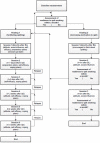An economic evaluation of a video- and text-based computer-tailored intervention for smoking cessation: a cost-effectiveness and cost-utility analysis of a randomized controlled trial
- PMID: 25310007
- PMCID: PMC4195710
- DOI: 10.1371/journal.pone.0110117
An economic evaluation of a video- and text-based computer-tailored intervention for smoking cessation: a cost-effectiveness and cost-utility analysis of a randomized controlled trial
Abstract
Background: Although evidence exists for the effectiveness of web-based smoking cessation interventions, information about the cost-effectiveness of these interventions is limited.
Objective: The study investigated the cost-effectiveness and cost-utility of two web-based computer-tailored (CT) smoking cessation interventions (video- vs. text-based CT) compared to a control condition that received general text-based advice.
Methods: In a randomized controlled trial, respondents were allocated to the video-based condition (N = 670), the text-based condition (N = 708) or the control condition (N = 721). Societal costs, smoking status, and quality-adjusted life years (QALYs; EQ-5D-3L) were assessed at baseline, six-and twelve-month follow-up. The incremental costs per abstinent respondent and per QALYs gained were calculated. To account for uncertainty, bootstrapping techniques and sensitivity analyses were carried out.
Results: No significant differences were found in the three conditions regarding demographics, baseline values of outcomes and societal costs over the three months prior to baseline. Analyses using prolonged abstinence as outcome measure indicated that from a willingness to pay of €1,500, the video-based intervention was likely to be the most cost-effective treatment, whereas from a willingness to pay of €50,400, the text-based intervention was likely to be the most cost-effective. With regard to cost-utilities, when quality of life was used as outcome measure, the control condition had the highest probability of being the most preferable treatment. Sensitivity analyses yielded comparable results.
Conclusion: The video-based CT smoking cessation intervention was the most cost-effective treatment for smoking abstinence after twelve months, varying the willingness to pay per abstinent respondent from €0 up to €80,000. With regard to cost-utility, the control condition seemed to be the most preferable treatment. Probably, more time will be required to assess changes in quality of life. Future studies with longer follow-up periods are needed to investigate whether cost-utility results regarding quality of life may change in the long run.
Trial registration: Nederlands Trial Register NTR3102.
Conflict of interest statement
Figures




References
-
- Civliak M, Sheikh A, Stead LF, Car J (2010) Internet based interventions for smoking cessation. Cochrane Database Syst Rev 9. - PubMed
-
- Shahab L, McEwen A (2009) Online support for smoking cessation: a systematic review of the literature. Addictive Behaviours 104: 1792–1804. - PubMed
-
- Lancaster T, Stead L (2005c) Self-help interventions for smoking cessation. Cochrane Database of Systematic Reviews: 1–91. - PubMed
Publication types
MeSH terms
Associated data
LinkOut - more resources
Full Text Sources
Other Literature Sources
Medical

